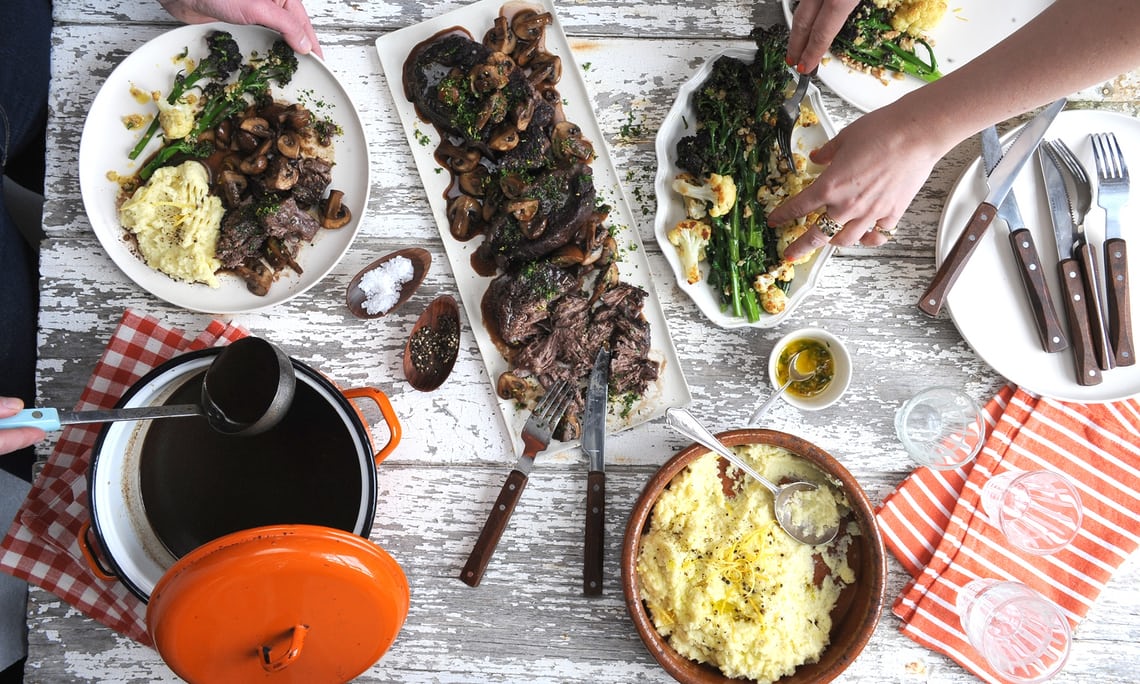A slow-cooked beef feast to cook for guests this weekend
This sumptuous slow-cooked, French-inspired beef recipe is sure to convince you and your guests of the benefits of taking things slowly, not to mention the creamed parsnip and vegetables with walnut and tarragon dressing

A slow-cooked French feast... Leave the flour out of the gravy for a thin, but still delicious, gluten-free version. Photograph: Jill Mead for the Guardian
Jane Baxter and Henry DimblebyCooking in the classical tradition, where multiple steps are required to create lustrous sauces with deep, complex flavours, is falling out of fashion. But there are some dishes that cannot be done better any other way, and slow-cooked beef is one of them.
If I were forced to choose a last supper, it would be beef cooked like this – served in a silky sauce and so soft you can cut it with a spoon. I was introduced to it years ago in Paris by Bambi Sloan, who helped decorate our early Leon restaurants. (She's French. She's an interior designer. It's her real name.) That night the beef was ox cheek. It came to the table in the dish it had been cooked in, alongside a large bowl of soft, smooth mash. We spooned both on to our plates and swooned.
The secret is to strain the vegetables after they have been cooked to leave you with a luxuriant sauce, and to use a cut of meat with plenty of connective tissue. During the slow cooking, the connective tissue breaks down and makes the meat succulent – almost gooey. The meat and vegetables themselves will thicken the gravy, but it does no harm to give it a little help. In Paris, this was done by adding a marrow bone during the cooking process, but we have used the more prosaic flour. (You can leave even that out if you want it to be gluten-free – your sauce will be thinner but still delicious.)
In today's recipe, Jane has combined the beef with an equally smooth parsnip puree, some gremolata to give it zing, and seasonal cauliflower and purple sprouting broccoli for crunch.
Braised featherblade
Featherblade is a cheaper cut of beef from the shoulder of the animal. The top part of it is sometimes sold under the American name, flat iron steak. But be warned: it will have been carefully trimmed of all the sinewy bits that, when cooked for a long time, make this recipe so delicious. It will also be much more expensive.
Serves 4 -61 Preheat the oven to 140C/275F/gas mark 1. Dust the beef with the seasoned flour.
2 Heat the butter and oil in a large frying pan. Brown the meat well on all sides and remove from the pan.
3 Add the veg to the pan and brown for 5 minutes over a medium heat. Stir in the garlic and herbs and cook for a minute. Deglaze the pan (scrape the bits off the bottom) with the red wine, vinegar and stock. Bring to the boil.
4 Transfer the meat to an oven-proof casserole dish, then tip over the hot stock and vegetables. Season well. Cover tightly and place in the oven for about 2 ½ to 3 ½ hours or until the beef is tender. The length of time will depend on the thickness of the beef.
5 When cooked, remove the meat from the stock and set to one side in a container that will fit in your fridge. Strain this in a sieve (pushing the softer vegetables through to thicken it) and pour it over the meat. Allow to cool and leave in the fridge until needed.
To finishFor the gremolata
1 Take the beef out of the stock. Cut it across the grain into 1-2cm thick slices.
2 In a large frying pan, heat the oil and butter until hot, then saute the mushrooms for a few minutes until golden brown and tender. Season well.
3 Remove the mushrooms from the pan. Add the beef stock and the mustard to the pan. Whisk together and bring to the boil for as long as needed to reduce the sauce to the desired thickness.
4 Add the mushrooms and sliced beef to the hot sauce. Simmer gently for a few minutes to heat through. Season if required.
5 Combine the parsley with the lemon zest and garlic to make gremolata, and sprinkle over the beef before serving.
Creamed parsnip
Serves 4-61 Place in a pan with the milk and bring to the boil. Simmer for about 20 minutes, or until the parsnips are soft.
2 Drain well and transfer to a food processor. Add the garlic, lemon and almonds. Blitz and slowly add the olive oil until you have a puree the consistency of a light mash. Season well and serve.
Roast cauliflower and purple sprouting broccoli with walnut-tarragon dressing
Serves 4-6For the dressing
1 Preheat the oven to 160C/325F/gas mark 3. Break the cauliflower into small florets. Toss in the olive oil and season well. Place on a baking tray in a medium oven for about 20 minutes or until the cauliflower is tender and slightly browned.
2 Make the dressing by blending all the ingredients together with half the walnuts – either use a stick blender or whisk.
3 Trim the broccoli and blanch in boiling salted water for 3 minutes until tender. Drain well. Toss with the cauliflower and the dressing. Sprinkle with extra walnuts.
Henry Dimbleby is co-founder of the natural fast-food restaurant chain Leon. Twitter: @henry_leon. Jane Baxter is a chef and food writer based in Devon. Twitter: @Baxcooka